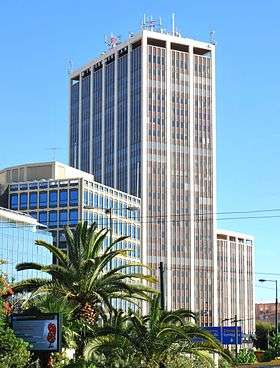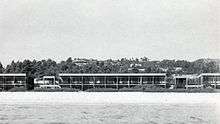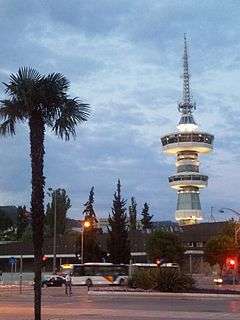Greek economic miracle

The Greek economic miracle is the period of sustained economic growth in Greece from 1950 to 1973. During this period, the Greek economy grew by an average of 7.7%, second in the world only to Japan.[1][2][3][4][5][6][7][8][9][10][11][12][13][14][15][16][17]
Background
From 1941 to 1944, during World War II, Axis occupation of Greece and the fierce fighting with Greek Resistance groups had unprecedented devastating effects on the infrastructure and economy. Forced loans demanded by the occupying regime severely devalued the Greek drachma. After the end of the war, there was a bitter civil war until 1949. By 1950, the relative position of the Greek economy had dramatically deteriorated. The income per capita in purchasing power terms fell from 62% of France's in 1938 to about 40% in 1949.[1]
Economic growth

The rapid recovery of the Greek economy following the Greek Civil War was facilitated by a number of measures, especially, as in other European countries, by the grants and loans of the Marshall Plan. They also included a drastic devaluation of the drachma, attraction of foreign investments, significant development of the chemical industry, development of tourism and the services sector in general and massive construction activity connected with huge infrastructure projects and rebuilding in the Greek cities.[18][19]
Greek growth rates were highest during the 1950s, often exceeding 10%, close to those of a modern tiger economy. Industrial production also grew annually by 10% for several years, mostly in the 1960s. Growth initially widened the economic gap between rich and poor, intensifying political divisions.[18]
In total, the Greek GDP grew for 54 of the 60 years following World War II and the Greek Civil War.[20] From 1950 until the 2008 economic crisis, with the exception of the relative economic stagnation of the 1980s, Greece consistently outperformed most European nations in terms of annual economic growth.[21]
Aftermath
Marginal GDP contractions were recorded in the 1980s, although these were partly counterbalanced by the evolution of the Greek black economy during that time. Between the early 1970s and 1990s, double-digit inflation, often closer to 20% than 10%, was normal until monetary policies were changed to comply with the criteria for joining the Eurozone.[22]
Gallery
-

Iron ore mine in Thasos (1958)
-

Shiploading in Limenaria, Thasos, during the 50s
-

Xenia hotel in Paliouri, Chalkidiki (1962)
-

Microcar Attica 200 of Attica automobiles (1963)
-

The Desert Bus of Greek vehicle manufacturer Biamax (1964)
-

OTE Tower of Thessaloniki opened in 1966
See also
References
- 1 2 Angus Maddison, "Monitoring the World Economy 1820-1992", OECD (1995)
- ↑ Graham T. Allison; Kalypso Nicolaïdis (January 1997). The Greek Paradox: Promise Vs. Performance. MIT Press. p. 43. ISBN 978-0-262-51092-9.
phase of 1960 to 1973 (the period hailed by many as the "Greek economic miracle"), gross domestic product grew at an average annual rate of 7.7 percent, but exports of goods and services grew at the much higher average rate of 12.6
- ↑ HAMISH MCRAE (27 June 2015). "Greece crisis: It needs another economic miracle – and it could happen". The Independent.
Indeed, between 1950 and the oil crisis of 1973 it was Europe’s fasting growing economy, with growth rates of 7 per cent a year. This period was dubbed the Greek economic miracle.
- ↑ Richard C. Frucht (2004). Eastern Europe: an introduction to the people, lands, and culture. Vol. 2. ABC-CLIO. p. 877. ISBN 978-1-57607-800-6.
... called Greek economic miracle. During these years, Greece's GDP grew at the fastest rate in Western Europe, averaging almost 8 percent annually. Meanwhile, industrial production grew at an average annual rate of 10 percent,ex- ceeded ...
- ↑ Lila Leontidou (26 April 1990). The Mediterranean City in Transition: Social Change and Urban Development. Cambridge University Press. p. 125. ISBN 978-0-521-34467-8.
In fact, the Greek economic miracle of industrialization was partly due to the suppression of the working class.
- ↑ Mehmet Odekon (17 March 2015). Booms and Busts: An Encyclopedia of Economic History from the First Stock Market Crash of 1792 to the Current Global Economic Crisis. Routledge. p. 322. ISBN 978-1-317-47576-7.
Several factors contributed to what became known as the “Greek economic miracle.” First was the country's participation in the Marshall Plan, a massive influx of U.S. capital aimed at jump-starting Western European economies in the wake of ..
- ↑ Shiva Pratap Singh (2010). Glimpses of Europe: A Crucible of Winning Ideas, Great Civilizations and Bloodiest Wars. Gyan Publishing House. p. 651. ISBN 978-81-7835-831-4.
Afier World War H, Greece experienced the “Greek economic miracle”; GDP growth averaged 7% between 1950 and 1973. Since then Greece has implemented number of structural and fiscal reforms while receiving, considerable European ...
- ↑ Stathis Kalyvas (3 April 2015). Modern Greece: What Everyone Needs to KnowRG. Oxford University Press. p. 88. ISBN 978-0-19-997346-0.
The efficiency with which the Greek nuclear family could pursue gain,” concludes McNeill, “by combination of hard work, shrewd exploitation of market opportunities, and rigorous saving for the future, lay behind the Greek economic miracle.
- ↑ Constantine Arvanitopoulos; Konstantina E. Botsiou (19 May 2010). The Constantinos Karamanlis Institute for Democracy Yearbook 2010. Springer Science & Business Media. p. 110. ISBN 978-3-642-12374-0.
The flats-for-land exchange programme changed the architecture in urban centres, and towards the end of the so-called Greek economic 'miracle' in the mid '70s, agriculture accounted for 18% of GDP, while industry accounted for about 30%.
- ↑ David H. Close (25 September 2014). Greece Since 1945: Politics, Economy and Society. Routledge. p. 56. ISBN 978-1-317-88001-1.
'Origins of the “Greek economic miracle”: the Truman Doctrine and Marshall Plan development and stabilisation programs', in Eugene Rossides (ed.), The Truman Doctrine for Aid to Greece. A Fiftieth Anniversary ...
- ↑ Elena Calandri; Antonio Varsori; Daniele Caviglia (26 November 2014). Détente in Cold War Europe: Politics and Diplomacy in the Mediterranean and the Middle East. I.B.Tauris. p. 17. ISBN 978-1-78076-108-4.
During 1950–1973, il boom in Italy, les Trente Glorieuses in France and the Greek 'Economic Miracle' were to transform the economies and societies of these countries.
- ↑ OECD (15 September 2008). The Marshall Plan Lessons Learned for the 21st Century: Lessons Learned for the 21st Century. OECD Publishing. p. 120. ISBN 978-92-64-04425-8.
The Marshall Plan began as an emergency program, but its sustained contributions to agriculture and finance succeeded in laying the foundation for the Greek economic miracle of the 1950s.
- ↑ Kathleen Burk (1 October 2009). Old World, New World: Great Britain and America from the Beginning. Grove Press. p. 735. ISBN 978-0-8021-4429-4.
The Origins of the Greek Economic Miracle', University College London PhD thesis ...
- ↑ Dimitris Keridis (1 July 2009). Historical Dictionary of Modern Greece. Scarecrow Press. p. 57. ISBN 978-0-8108-6312-5.
What followed, however, has been described as the Greek “economic miracle.” Through the stewardship of Prime Minister Konstantinos Karamanlis and of other Greek politicians, such as Georgios Kartalis and Spyros Markezinis, foreign aid ...
- ↑ Veronica Binda (26 June 2013). The Dynamics of Big Business: Structure, Strategy, and Impact in Italy and Spain. Routledge. p. 177. ISBN 978-1-134-06335-2.
After World War II, the presence of foreign multinationals also started to increase and the attraction of foreign capital was a goal actively pursued by governments in the years of the Greek economic miracle.
- ↑ United States. Congress. House. Foreign Affairs (1971). Greece, Spain, and the Southern NATO Strategy: Hearings Before the Subcommittee on Europe..., 92-1, July 12, 14, 19, 21, August 3, September 9, 15, 1971. p. 3.
During this period the foundations were laid and the first fruits were reaped — of what has come to be known as the "Greek economic miracle." Generally the 1950's could be characterized as a period of rapid economic development as well as ...
- ↑ Greek-American Review. 51-52. Hellenic Heritage. 1999. p. 20.
He writes on the origins of the "Greek Economic Miracle" and provides the longest and one of the most important papers.
- 1 2 Joanna Bens, Nikolaos Karagiannis, Abdelaziz Testas. EU Regional and Industrial Policies. In "Europe in Crisis: Problems, Challenges, and Alternative Perspectives", Palgrave Macmillan (2015) p. 174
- ↑ Elaine Thomopoulos, "The History of Greece", ABC-CLIO (2011) p. 152
- ↑ Paul Bairoch, "Europe's GNP 1800-1975," The Journal of European Economic History, a. 5, no. 2 (1976), pp. 273-340. ISSN 0391-5115
- ↑ IMF and World Bank April 2008 data
- ↑ http://www.global-rates.com/images/charts/gr-inflatie-chart-14-2043.jpg
Further reading
- Takis Fotopoulos, "Economic restructuring and the debt problem: the Greek case," International Review of Applied Economics, Vol. 6, No. 1 (1992). Retrieved: 5 May 2010.
